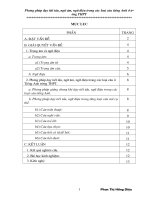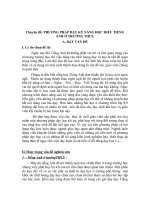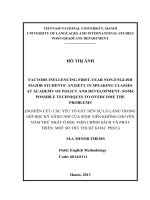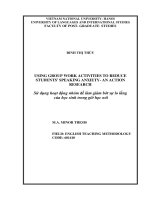Tìm hiểu về các yếu tố gây ra sự lo lắng của học sinh lớp 10 trong các giờ học đọc hiểu tiếng Anh ở trường THPT Tam Đảo
Bạn đang xem bản rút gọn của tài liệu. Xem và tải ngay bản đầy đủ của tài liệu tại đây (276.19 KB, 12 trang )
VIETNAM NATIONAL UNIVERSITY, HANOI
UNIVERSITY OF LANGUAGES AND INTERNATIONAL STUDIES
FACULTY OF POST-GRADUATE STUDIES
TRIỆU THỊ HOÀI THU
AN INVESTIGATION INTO FACTORS CAUSING THE 10TH STUDENTS’
ANXIETY IN ENGLISH READING COMPREHENSION CLASSES AT
TAM ĐẢO HIGH SCHOOL
(Tìm hiểu về các yếu tố gây ra sự lo lắng của học sinh lớp 10 trong các giờ học
đọc hiểu tiếng Anh ở trường THPT Tam Đảo)
M.A. MINOR PROGRAMME THESIS
Field: English Teaching Methodology
Code: 60140111
HANOI - 2016
VIETNAM NATIONAL UNIVERSITY, HANOI
UNIVERSITY OF LANGUAGES AND INTERNATIONAL STUDIES
FACULTY OF POST-GRADUATE STUDIES
TRIỆU THỊ HOÀI THU
AN INVESTIGATION INTO FACTORS CAUSING THE 10TH STUDENTS’
ANXIETY IN ENGLISH READING COMPREHENSION CLASSES AT
TAM ĐẢO HIGH SCHOOL
(Tìm hiểu về các yếu tố gây ra sự lo lắng của học sinh lớp 10 trong các giờ học
đọc hiểu tiếng Anh ở trường THPT Tam Đảo)
M.A. MINOR PROGRAMME THESIS
Field: English Teaching Methodology
Code: 60140111
Supervisor: Assoc. Dr. Ngô Hữu Hoàng
HANOI - 2016
TABLE OF CONTENTS
CANDIDATE’S STATEMENT ............................... Error! Bookmark not defined.
ACKNOWLEDGEMENTS ...................................... Error! Bookmark not defined.
ABSTRACT .............................................................. Error! Bookmark not defined.
LIST OF ABBREVIATIONS ................................... Error! Bookmark not defined.
LIST OF CHARTS AND TABLES .......................... Error! Bookmark not defined.
PART A: INTRODUCTION ...................................................................................... I
1. Rationale of the study .......................................................................................... I
2. Aims of the study ................................................................................................. I
3. Research questions .............................................................................................. II
4. Scope of the study ............................................................................................... II
5. Methodology ....................................................................................................... II
6. Significance of the study .................................................................................... II
7. Organization of the study.................................................................................... II
PART B: DEVELOPMENT .................................... Error! Bookmark not defined.
CHAPTER 1: LITERATURE REVIEW .................. Error! Bookmark not defined.
1.1. Reading ........................................................... Error! Bookmark not defined.
1.1.1. Definition of reading? .............................. Error! Bookmark not defined.
1.1.2. Definition of reading comprehension ....... Error! Bookmark not defined.
1.1.3. The importance of reading ....................... Error! Bookmark not defined.
1.2. Types of reading .......................................... Error! Bookmark not defined.
1.2.1. Skimming ................................................. Error! Bookmark not defined.
1.2.2. Scanning ................................................... Error! Bookmark not defined.
1.2.3. Extensive reading ..................................... Error! Bookmark not defined.
1.2.4. Intensive reading ...................................... Error! Bookmark not defined.
1.3. Stages of a reading lesson ............................... Error! Bookmark not defined.
1.3.1. Pre-reading ............................................... Error! Bookmark not defined.
1.3.2. While-reading ........................................... Error! Bookmark not defined.
i
1.3.3. Post- reading ............................................. Error! Bookmark not defined.
1.4. Anxiety............................................................ Error! Bookmark not defined.
1.4.1. Definition of anxiety ................................ Error! Bookmark not defined.
1.4.2. Foreign language reading anxiety ............ Error! Bookmark not defined.
1.5. Previous studies on the effect of anxiety on students’ reading comprehension
............................................................................... Error! Bookmark not defined.
1.6. Summary ......................................................... Error! Bookmark not defined.
CHAPTER 2: METHODOLOGY ............................ Error! Bookmark not defined.
2.1. Research method ............................................. Error! Bookmark not defined.
2.1.1. The nature of qualitative research ............ Error! Bookmark not defined.
2.1.2. Selection of survey research as research strategy .. Error! Bookmark not
defined.
2.2. The context of the study ................................. Error! Bookmark not defined.
2.2.1. An introduction of Tam Dao high schoolError! Bookmark not defined.
2.2.2. The teaching material and reading tasks in teaching reading ......... Error!
Bookmark not defined.
2.3. Participants...................................................... Error! Bookmark not defined.
2.4. Instruments...................................................... Error! Bookmark not defined.
2.4.1. Questionnaire............................................ Error! Bookmark not defined.
2.4.2. Semi-structured interview ........................ Error! Bookmark not defined.
2.5. Data collection procedure ............................... Error! Bookmark not defined.
2.6. Data analysis procedure .................................. Error! Bookmark not defined.
2.7. Summary ......................................................... Error! Bookmark not defined.
CHAPTER 3: DATA ANALYSIS AND DISCUSSION ....... Error! Bookmark not
defined.
3.1. Students' attitude towards the importance of reading ... Error! Bookmark not
defined.
3.2. Students’ interest in English reading lessons . Error! Bookmark not defined.
ii
3.3. Reading anxiety caused by each reading factors .......... Error! Bookmark not
defined.
3.3.1. Anxiety caused by reading text factors .... Error! Bookmark not defined.
3.3.2. Anxiety caused by personal factors .......... Error! Bookmark not defined.
3.3.3. Anxiety caused by time constraint ........... Error! Bookmark not defined.
3.4. Students’ opinions on teachers’ teaching method ........ Error! Bookmark not
defined.
3.5. Teaching methods in helping students overcome anxiety in reading ..... Error!
Bookmark not defined.
3.6. Discussion ....................................................... Error! Bookmark not defined.
3.7. Summary ......................................................... Error! Bookmark not defined.
CHAPTER 4: SUGGESTED SOLUTIONS ............. Error! Bookmark not defined.
4.1. Raise students’ self - awareness of anxiety .... Error! Bookmark not defined.
4.2. Increase student’s self-confidence .................. Error! Bookmark not defined.
4.3. Improve students’ background knowledge ..... Error! Bookmark not defined.
4.4. Apply appropriate reading strategies .............. Error! Bookmark not defined.
4.5. Develop supplementary reading materials ..... Error! Bookmark not defined.
4.6. Create a pleasant and comfortable classroom atmosphere .. Error! Bookmark
not defined.
4.7. Summary ......................................................... Error! Bookmark not defined.
PART C: CONCLUSION ......................................... Error! Bookmark not defined.
1. Summary of the study ........................................ Error! Bookmark not defined.
2. Limitations of the study ..................................... Error! Bookmark not defined.
3. Recommendations for the further study ............ Error! Bookmark not defined.
REFERENCES ......................................................................................................... IV
APPENDICES........................................................... Error! Bookmark not defined.
iii
PART A: INTRODUCTION
1. Rationale of the study
It is indisputable that English plays an important role in teaching and
learning as a foreign language. However, to master English, learners need to grasp a
lot of different skills such as listening, speaking, reading and writing. Among these
skills, reading is the most crucial skill that not only develops other skills such as
speaking, listening and writing but also expands the students’ knowledge of the
language However, according to (Saito, Horwitz, & Garza, 1999), “reading is an
important source of input; however, it is also an anxiety provoking activity”.
Therefore, it can be undeniable that it is a difficult or a challenge to improve and
develop reading skills for both teachers and students.
In fact, in reading lessons in Tam Dao high school, teachers always try to
effectively transmit how to understand and exploit the reading text for students.
However, most of students share that they find that learning foreign language
reading as English is affected by the personal factors, especially anxiety. Therefore,
the effectiveness of students’ reading comprehension is not as expected and they
have little attention or motivation in reading lessons.
While a certain amount of research has been conducted to investigate foreign
language anxiety and its effect on learn a foreign language, little has been done on
anxiety in learning four skills, especially reading alone in Vietnam. As a teacher of
English in this school, I recognize the importance of reading, it is strongly desirable
for me to propose “An investigation into factors causing the 10th students’ anxiety
in English reading comprehension classes at Tam Đảo high school” to be the subject
of this thesis.
2. Aims of the study
The main aim of this study is to investigate the effect of students’ anxiety on
reading comprehension and then suggests some solutions to reduce their reading
anxiety.
I
3. Research questions
To achieve the aims mentioned above, the following research questions are
proposed:
1) . What are the causes that affect students’ anxiety at Tam Dao high school
in reading lessons?
2) . What are some suggested solutions to reduce students’ anxiety on reading
comprehension?
4. Scope of the study
This study focuses on students’ anxiety on reading comprehension. Due to
the limitation of page numbers of the minor thesis, the research only involves the
10th form students at Tam Dao high school.
5. Methodology
To achieve the aims of the study, qualitative method is employed. The data
was collected by means of survey questionnaires and semi-structured interviews.
After the data is collected, analyzed and discussed, some conclusions will be drawn,
and some suggestions will be made in the thesis.
6. Significance of the study
This study investigates the causes of anxiety on students’ reading
comprehension. It could be of some help to teachers and students at Tam Dao high
school to improve both teachers and students’ awareness of causes of reading
comprehension anxiety. By doing this research, the researcher wishes to help the
10th form students to reduce their reading anxiety through the suggested solutions.
7. Organization of the study
The research consists of three main parts: Introduction, Development and
Conclusion.
Part A: Introduction presents the rationale, the aims, the research questions,
methods, scope, significance and organization of the study.
Part B: Development consists of four chapters:
II
Chapter 1 Literature review gives the concepts of reading, reading
comprehension, its importance, types of reading and stages of a reading lesson.
Next, the concepts of anxiety, foreign language reading anxiety and the previous
studies on anxiety in reading comprehension are presented.
Chapter 2 Methodology includes the research method, the context,
participants, instruments and research procedure with the following main steps:
conducting survey questionnaires and interview collecting data and analyzing data,
and giving out conclusions from findings.
Chapter 3 Analyses were given on students’ attitude and interests on reading,
their sources of anxiety, their opinions of teachers’ teaching methods and how to
cope with their anxiety chapter also focuses on data collections - findings and
discussion.
Chapter 4 Some suggested solutions of the study for improving reading skills
to the students at Tam Dao high school are proposed.
Part C: Conclusion is the last part which offered a summary, some
limitations and suggestions for further studies.
III
REFERENCES
1. Aebersold, J. A., & Field, M. L. (Ed.). (1997). From reader to reading teacher:
Issues and strategies for second language classrooms. New York, NY:
Cambridge University Press.
2. Anderson, N. (1999). Improving reading speed: Activities for the classroom.
English teaching forum, 37, 2-5.
3. Brown, H. D. (2001). Principles of Languagr Learning. Beijing: Foreign
Language Teaching and Research Press, 141-142.
4. Cohen, L., Manion, L., & Morrison, K. (2007). Research methods in education
(6th ed.). Abingdon: Routledge.
5. Creswell, J. W. (2009). Research design: Qualitative, quantitative, and mixed
methods approaches (3rd ed.). Thousand Oaks, CA: Sage.
6. Draper, A.K. (2004) The Principles and Application of Qualitative Research.
Proceedings of the Nutrition Society, 63, 641-646. doi:10.1079/PNS2004397
7. Gardner, R. C., & MacIntyre, P. D. (1993). A student's contributions to secondlanguage learning. Part II: Affective variables. Language Teaching, 26(1), 1-11.
8. Gebhard, J. G. (1987). A successful Comprehension: What Teachers can do
before students read. English Teaching Forum, 25 (2).
9. Goodman, K. S. (1976). Reading: A Psycholinguistic Guessing Game. In Singer,
H., & Ruddell, R.B. (Eds.), Theoretical Models and Processes of Reading (2nd
ed.), 497-508.
10. Grabe, W. (1991). Current developments in second language reading research.
TESOL Quaterly, 25(3), 375-406. doi:10.2307/3586977
Grellet, F. (1981). Developing Reading Skills. Cambridge: Cambridge University
Press.
11. Harmer, J. (1991). The Practice of English Language Teaching. New York:
Longman Publishing, 109-121.
12. Hedge, T. (2003). Teaching & learning in the language classroom. UK: OUP.
IV
13. Horwitz, E., Horwitz, M., & Cope. J. (1986). Foreign language classroom
anxiety. Modern Language Journal, 70, 125-132.
14. Jafarigohar, M. (2012). The Effect of Anxiety on Reading Comprehension
among Distance EFL Learners.International Education Studies, 5(2), 159-174.
15. Jones, J. (2001). A Cultural Context for Language Anxiety. EA journal, 21(2).
16. Kelley, K., Clark, B., Brown, V., & Sitzia, J. (2003). Good practice in the
conduct and reporting of survey research. Int J Qual Health Care,15, 261-266.
17. Kuru Gönen,S. İ. (2009). The sources of foreign language reading anxiety of
students in a Turkish EFL context. Paper presented at the 5th WSEAS/IASME
International Conference on EDUCATIONAL TECHNOLOGIES (EDUTE' 09),
Spain.
18. Lewis, M., & Hill, J. Practical Techniques for Language Teaching. London :
Commercial Colour Press,1990. ISBN 0-90717-55-8.
19. Linse, T. C. (2005). Practical English Language Teaching, Young Learners.
New York: McGraw-Hill.
20. MacIntyre, P. D., & Gardner, R. C. (1994a). The effects of induced anxiety on
three stages of cognitive processing in computerized vocabulary learning, Studies
in Second Language Acquisition, 16, 1-17.
21. Nunan, D. (1992), Research Methods in Language Learning, Cambridge: CUP
22. Saito, Y., Horwitz, E. K., & Garza, T. J. (1999). Foreign language reading
anxiety. Modern Language Journal, 83, 202 -218.
23. Scovel, T. (1978). The effect of affect on foreign language learning: a review of
the anxiety research. Language Learning, 28, 128-142.
24. Snow, C. E., & Sweet, A. P. (2003). Reading for comprehension. In A. P. Sweet
& C. E. Snow (Eds.), Rethinking reading comprehension, 1-11. New York:
Guilford Press.
25. Um, S., Tubsree, C., & Surasin, J. (2014). Perception on English Reading
Comprehension Anxiety of Third Year EFL Students at the Institute of Foreign
Languages, Cambodia. HRD JOURNAL, 4(1), 34-46.
V
26. Williams, E. (1984). Reading in language classroom. London: Macmillan
Wu, H. J. (2011). Anxiety and reading comprehension performance in English as a
foreign language. Asian EFL Journal, 13(2), 273−307.
27. Young, D. J. (1991). Creating a low-anxiety classroom environment: What does
language anxiety research suggest? The Modern Language Journal, 75, 426439. doi:10.2307/329492
Internet websites:
28. Al-Shboul, M., Ahmad, I., Nordin, M., & Rahman, Z. (2013). Foreign Language
Reading Anxiety in a Jordanian EFL Context: A Qualitative Study. English
Language Teaching, 6 (6). Retrieved from
/>29. Brantmeier, C. (2005). Anxiety about L2 reading or L2 reading tasks? A study
with advanced language learners. Reading Matrix, 5, 67-83. Retrieved from
/>30. Bricki, N & Green, J. (2007). A Guide to Using Qualitative Research
Methodology. Retrieved from
/>h%20methodology.pdf
31. Bruce, B. (2004). Developing and implementing extensive reading within a
reading program, 175-188. Retrieved from
/>32. Cabansag, J. N. (2013). English language anxiety and reading comprehension
performance of college students in a State university. International refereed
research
journal,
4
(4),
20-31.
Retrieved
from
/>33. Day, R. R., & Bamford, J. (2002). Top ten principles for teaching extensive
reading. Reading in a Foreign Language, 14,1 36-141. Retrieved from
/>
VI
34. Denscombe, M. (2007). The good research guide: for small-scale social
research projects (3rd ed.). Maidenhead: Open University Press. Retrieved from
/>_research_guidebookfi-org.pdf
35. Deyuan, B., & Yufen, G. (2006). Reading in three stages. CELEA Journal. 29
(4), 124-126. Retrieved from />36. Lien, H. Y. (2011). EFL learners’ reading strategy use in relation to reading
anxiety. Language Education in Asia, 2(2), 199-212. Retrieved from
/>L_Learners_Reading_Strategy_Use_in_Relation_to_Reading_Anxiety.pdf
37. Loucky, J.P. (2005). Combining Intensive and Extensive Reading Strategies
with Co-operative and Communicative Learning Activities. Retrieved from
/>38.
Macleod,
M.
(n.d.).
Types
of
Reading.
Retrieved
from
/>39. Shao, X. (2014). A Study of Chinese College Students’ English Reading
Anxiety. American Journal of Educational Research, 2(5), 299-303. Retrieved
from />40. Susser, B., & Robb, T. N. (1990). EFL Extensive Reading Instruction: Research
and
Procedure.
JALT
Journal,
12(2),
/>
VII
161-185.
Retrieved
from









